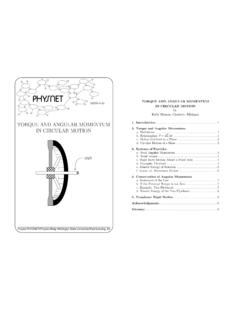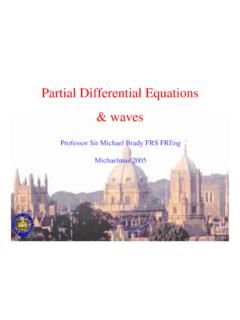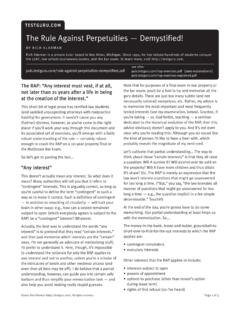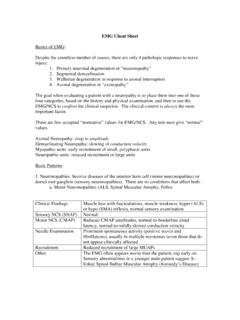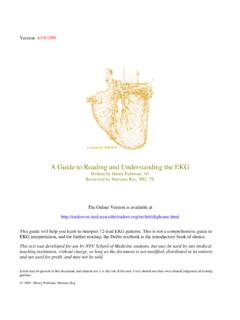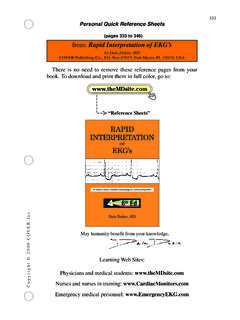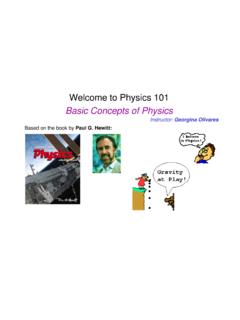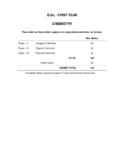Transcription of ELECTROMAGNETIC WAVES FROM MAXWELL’S …
1 Project PHYSNETP hysics Bldg. Michigan State University East Lansing, MI MISN-0-210 ELECTROMAGNETICWAVESFROMMAXWELL'SEQUATIO NS yzxcB`E`1 ELECTROMAGNETICWAVESFROMMAXWELL'SEQUATIO NSbyPeterSignellMichiganStateUniversity1 . Introductiona. Background.. 1b. WAVES in Space..1c. VectorDerivatives .. 1d. PartialDerivatives .. 22. VectorDerivativesa. TheGradient Operator..2b. TheDivergenceOperator..2c. TheCurlOperator.. 33. maxwell 'sEquations.. 34. ElectromagneticWavesa. No Charge,No Current; WAVES .. 3b. Plane-PolarizedMonochromaticWaves .. 4c. Productionby a RadioTransmitter.
2 5d. How TheWaves ManifestThemselves .. 6 Acknowledgments..6 Glossary.. 6A. TheCurlas a Determinant.. 6B. Proof of a VectorIdentity..72ID Sheet: MISN-0-210 Title:ElectromagneticWaves fromMaxwell'sEquationsAuthor:P. Signell,MichiganStateUniversityVersion:1 0/18/2001 Evaluation:Stage0 Length:1 hr; 20 pagesInputSkills:1. Vocabulary:chargedensity (MISN-0-147),current density (MISN-0-118),displacement (MISN-0-25),soundwaves, wave frequency,wavelength, WAVES on strings,wave speed (MISN-0-202),waveequation(MISN-0-201).2. Take derivatives of transcendental functions(MISN-0-1).
3 3. Take scalarandvectorproductsof vectorsusingCartesianunitvectors(MISN-0- 2).OutputSkills(Knowledge) :propagation(of a wave), polarization(directionof),plane-polarize d(wave), monochromatic(wave). maxwell 'sEquations,the \curl-curl"vectoridentity, andthe de nitionsof the gradient, divergence,and curl operators,de-rive the wave equationsfor electricand magnetic (RuleApplication) the de nitionsof the gradient, divergence,and curlopera-tors,verifythata given electromagneticwave, consistingof cou-pledelectricand magneticwaves, satis esMaxwell' the directionof polarization,directionof propagation,fre-quencyandamplitudeof a monochromaticplane-polarizedelec-tromagn eticwave, writedown the electricand magnetic the :1.
4 \EnergyandMomentumin ElectromagneticWaves,"(MISN-0-211).2. \Brewster'sLaw and Polarization,"(MISN-0-225).3 THISIS A DEVELOPMENTAL-STAGE PUBLICATIONOF PROJECTPHYSNETThe goalof our project is to assista network of educatorsand scientistsintransferringphysicsfromone personto support manuscriptprocessingand distribution,alongwithcommunicationand alsowork withemployers to identify basicscienti cskillsas well as physicstopicsthatare neededin scienceandtechnology. Anumber of our publicationsare aimedat assistingusersin designed:(i) to be updatedquickly in responseto eldtestsand newscienti cdevelopments; (ii) to be usedin both class-room andprofessionalsettings;(iii)to show the prerequisitedependen-ciesexistingamongth e variouschunksof physicsknowledgeandskill,as a guideboth to mental organizationand to use of the materials;and(iv) to be adaptedquickly to speci cuserneedsrangingfromsingle-skillinstruc tionto ,reviewers and eldtestersare DirectorADVISORY COMMITTEED.
5 AlanBromleyYale UniversityE. LeonardJossemTheOhioStateUniversityA. A. StrassenburgS. U. N. Y., Stony BrookViewsexpressedin a moduleare thoseof the moduleauthor(s)and arenot necessarilythoseof otherproject 2001,PeterSignellfor Project PHYSNET,Physics-Astronomy Bldg.,Mich. StateUniv.,E. Lansing,MI 48824;(517) our liberaluse policiessee: 'SEQUATIONSbyPeterSignellMichiganStateUn iversity1. of energythroughmechanicalsys-temsvia the collective motionof the particlesthatmake up the systemisa familiarphenomenon,spectacularlydemonstr ated,for example,whenthe voiceof a sopranoshattersa glassacrossthe room carriedby the \displacement" WAVES thatcan be madeto propa-gatethroughthe system(the\displacement" referringto the displacementfromequilibriumof the particlesof the systemor of the pressurein thegas).
6 In is alsopossiblefor electricandmagnetic eldsto propagateas WAVES in empty space,the electricandmagnetic eldvectorsplayingthe samerole in electromagneticwaves as the trans-verse displacement of the particlesof a stringdo in WAVES alonga stretchedstring,or the pressuredisplacement associatedwiththe propagationofsoundwaves in air. Theimportant di erenceis thatthereis no mediumthroughwhich thiselectromagneticwave propagates,althoughperhapsone couldsay the \medium"is the vacuum!Electricand magnetic eldsmay existin spacewithouta materialmediumbeingpresent, and if theyvary in spaceand timein the appropriateway, the spatialvariationwillpropagateas a wave, transportingenergy.
7 Thismoduledealswiththepropagationof energythrougha vacuumvia electromagneticdisturbanceswhosespaceand timevariationsatisfythe conditionsfor wave dealwithelectromagneticwaves in spaceit is far easierto use maxwell 's electricity and magnetismwe are dealingwithscalar eldslike the chargedensity andvector eldslike~E, andwe will ndthatwe must dealwiththreekindsof derivative operators:the \gradient"operatorthatoperateson a scalar eldandproducesa vectorone,the\divergence"operatorthatope rateson a vector eldand producesa scalarone,and the \curl"operatorthatoperateson a vector eldand of eldquantitieswe generallyuse \partialderivatives,"denoted@, to remindus thatthespatialcoordinatesare not functionsof , whereasa particlehas a singlevalueof, say,x, at any particulartime,a eldhas valuesat acontinuumof valuesofx.
8 Otherwise,partialderivatives are like ordinaryderivatives:@@x x3y4z5 = 3x2y4z5;@@x(sin 3xcosy) = 3 cos 3xcosy :2. VectorDerivatives2a. TheGradient operatoroperateson ascalarfunctionand producesa vectorfunctionthatis the steepest \up-hill"slope at any point wherethe vectorfunctionis ,the gradient of a function,evaluatedat somespace-point, points in thedirectionthatis moststeeply\up hill"in thatfunctionat thatpoint. Themagnitudeof the gradient is the valueof the slope in the \steepest ascent"directionat thatspace-point. As an example,suppose the gradient of a eldscalar eldfis the vector eld~g.
9 In Cartesiancoordinatesthis is:~g=~rf ^x@f@x+ ^y@f@y+ ^z@f@z:(1) Show that~r(x3y4) = (3x2y4)^x+ (4x3y3)^ The \divergence"operatoroperateson a vectorfunction,say~g(x; y; z), to give a scalarfunctionf(x; y; z):f=~r ~g @gx@x+@gy@y+@gz@z:(2)Thedivergenceof a vectorfunction,evaluatedat somespace-point,gives the extent to which the functionhas a sourceor sinkat example,the divergenceof an electric eldgives the chargedensityat thatpoint (positive chargesare sourcesfor the eld,negative chargesare sinks). Show that:~r x3y4z5 ^z= \curl"operatoroperateson a vectorfunction,say~g(x; y; z), to give anothervectorfunction:~r ~g @gy@x @gx@y ^z+ @gz@y @gy@z ^x+ @gx@z @gz@x ^y :(3)Thecurlof a function,evaluatedat somespace-point, gives the greatest\circulation"at thatpoint, whereby \circulation"one meansthe lineintegralof the functionarounda loop of in the curlis normalto the planeof the loop withthe Show that:~r x3y4z5 ^z= 4x3y3z5 ^x 3x2y4z5 ^ maxwell 'sEquationsHereare the famousMaxwell'sEquationsin di erential form:~r ~E= 4 ke ;(4)~r ~B= 0;(5)~r ~E= @~B@t.
10 (6)~r ~B= 4 kmj+c 2@~E@t:(7)Gauss'slaw is the integralformof Eq. (4). Ampere'slaw is the integralformof Eq. (7) for the casewherethe electric elddoes not vary Ampere-Laplace-Biot-Savart law is derived froma combinationof Eqs.(5) and (7), also for the casewherethe electric elddoes not of magneticinductionis the integralformof Eq. (6).4. ElectromagneticWaves4a. No Charge,No Current; the casewherethereisno chargeor current at a point in space,it is easyto show thatwaves set = 0 andj= 0 in Eqs.(4)-(7), thentake the timederivative of both sidesof Eqs.(6) and (7):Help:[S-3]1c2@2~E@t2=~r @~B@t;1 For anotherway to remember the de nitionof the curl,see @2~B@t2= ~r @~E@t:We now put Eqs.
